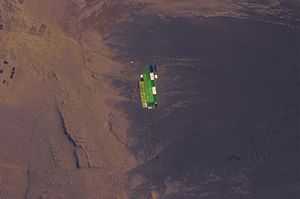Solar pond

A solar pond is a pool of saltwater which acts as a large-scale solar thermal energy collector with integral heat storage for supplying thermal energy. A solar pond can be used for various applications, such as process heating, desalination, refrigeration, drying and solar power generation.
Description
A solar pond is simply a pool of saltwater which collects and stores solar thermal energy. The saltwater naturally forms a vertical salinity gradient also known as a "halocline", in which low-salinity water floats on top of high-salinity water. The layers of salt solutions increase in concentration (and therefore density) with depth. Below a certain depth, the solution has a uniformly high salt concentration.
There are 3 distinct layers of water in the pond:
- The top layer, which has a low salt content.
- An intermediate insulating layer with a salt gradient, which establishes a density gradient that prevents heat exchange by natural convection.
- The bottom layer, which has a high salt content.
If the water is relatively translucent, and the pond's bottom has high optical absorption, then nearly all of the incident solar radiation (sunlight) will go into heating the bottom layer.
When solar energy is absorbed in the water, its temperature increases, causing thermal expansion and reduced density. If the water were fresh, the low-density warm water would float to the surface, causing a convection current. The temperature gradient alone causes a density gradient that decreases with depth. However the salinity gradient forms a density gradient that increases with depth, and this counteracts the temperature gradient, thus preventing heat in the lower layers from moving upwards by convection and leaving the pond. This means that the temperature at the bottom of the pond will rise to over 90 °C while the temperature at the top of the pond is usually around 30 °C. A natural example of these effects in a saline water body is Solar Lake in the Sinai Peninsula of Egypt.
The heat trapped in the salty bottom layer can be used for many different purposes, such as the heating of buildings or industrial hot water or to drive an organic Rankine cycle turbine or Stirling engine for generating electricity.
Advantages and disadvantages
- The approach is particularly attractive for rural areas in developing countries. Very large area collectors can be set up for just the cost of the clay or plastic pond liner.
- The evaporated surface water needs to be constantly replenished.
- The accumulating salt crystals have to be removed and can be both a valuable by-product and a maintenance expense.
- No need of a separate collector for this thermal storage system.
Efficiency
The energy obtained is in the form of low-grade heat of 70 to 80 °C compared to an assumed 20 °C ambient temperature. According to the second law of thermodynamics (see Carnot-cycle), the maximum theoretical efficiency of a cycle that uses heat from a high temperature reservoir at 80 °C and has a lower temperature of 20 °C is 1−(273+20)/(273+80)=17%. By comparison, a power plant's heat engine delivering high-grade heat at 800 °C would have a maximum theoretical limit of 73% for converting heat into useful work (and thus would be forced to divest as little as 27% in waste heat to the cold temperature reservoir at 20 °C). The low efficiency of solar ponds is usually justified with the argument that the 'collector', being just a plastic-lined pond, might potentially result in a large-scale system that is of lower overall levelised energy cost than a solar concentrating system.
Development
Further research is aimed at addressing the problems, such as the development of membrane ponds. These use a thin permeable membrane to separate the layers without allowing salt to pass through.
Examples
The largest operating solar pond for electricity generation was the Beit HaArava pond built in Israel and operated up until 1988. It had an area of 210,000 m² and gave an electrical output of 5 MW.[1]
The first solar pond in India (6000 m²) was built at Bhuj. The project was sanctioned under the National Solar Pond Programme by the Ministry of Non-Conventional Energy Sources in 1987 and completed in 1993 after a sustained collaborative effort by TERI, the Gujarat Energy Development Agency, and the GDDC (Gujarat Dairy Development Corporation Ltd). The solar pond successfully demonstrated the expediency of the technology by supplying 80,000 litres of hot water daily to the plant. The Energy and Resources Institute provided all technical inputs and took up the complete execution of research, development, and demonstration. TERI operated and maintained this facility until 1996 before handing it over to the GDDC. The solar pond functioned effortlessly till the year 2000 when severe financial losses crippled GDDC. Subsequently, the Bhuj earthquake left the Kutch Dairy non-functional.[2]
The 0.8-acre (3,200 m2) solar pond powering 20% of Bruce Foods Corporation's operations in El Paso, Texas is the second largest in the U.S. It is also the first ever salt-gradient solar pond in the U.S.[3]
See also
- Ocean thermal energy conversion
- Ice pond
- Seasonal thermal energy storage (STES)
- Thermal storage
- Deep lake water cooling
- Cooling pond
- Salt evaporation pond
References
- ↑ C, Nielsen; A, Akbarzadeh; J, Andrews; HRL, Becerra; P, Golding (2005), The History of Solar Pond Science and Technology, Proceedings of the 2005 Solar World Conference, Orlando, FL
- ↑ Solar Gradient Solar Ponds, Teriin, retrieved 28 November 2009.
- ↑ MacInnis, Roberta (March 30, 1987), "Solar pond producing power for Texas cannery", Energy User News (Bentley upper school library (Baisl): General OneFile, Gale) 8 (1), retrieved 8 Oct 2009.
External links
- The El Paso Solar Pond, University of Texas.
- Bhuj Solar Pond in India, Teriin.
- "Israel’s 150 KW Solar Pond", Mother Earth news, May–Jun 1980.
- Research ponds and real world project at Pyramid Salt, Pyramid Hill, Northern Victoria, AU: Royal Melbourne Institute of Technology.
| ||||||||||||||||||||||||||||
